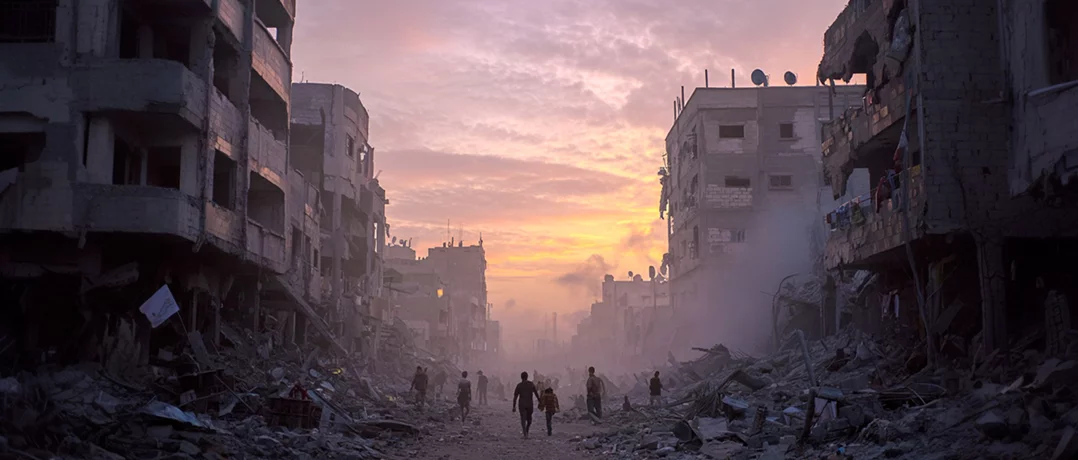A truce on paper, a war on the ground
The end of the Gaza war, between a fragile truce and negotiations amid famine and ruin
The end of the Gaza war, between a fragile truce and negotiations amid famine and ruin


The war in Gaza has formally ended, though the shelling has merely slowed without ceasing entirely. It now seems a matter of days or weeks at most before the first phase of U.S. President Donald Trump’s plan is implemented. In the meantime, delegations have entered a new round of negotiations in Cairo, mediated by Egypt, Qatar, and Turkey, and driven directly by Washington.
The U.S. plan on the table centers on “a prisoner–hostage exchange, a phased Israeli withdrawal from Gaza, the appointment of a transitional administration chaired by Trump with former British Prime Minister Tony Blair as his deputy overseeing a Palestinian governing body, and, most crucially, the disarmament of Hamas and other factions”.
American pressure has already yielded tangible progress: a Hamas delegation, led by Khalil al-Hayya, has arrived in Cairo to begin talks on implementation mechanisms. But in an effort to preserve its public image, Hamas has been framing its acceptance as only “partial”, insisting on guarantees of a complete withdrawal and permanent ceasefire. Washington, however, insists that any acceptance must be of the plan in its entirety, “without fragmentation”.
The Arab and Islamic response has also been emphatic. A joint statement released Sunday by regional foreign ministers -including key Hamas sponsors Turkey and Qatar- endorsed the whole deal, explicitly committing to the release of hostages and to all provisions of the plan, including disarmament and governance.
An Arab source in Jerusalem told “Beiruter” that the technical negotiations for the plan’s first phase were advancing rapidly, with completion expected “within days” due to sustained U.S. pressure. Public statements by Hamas, he said, are aimed solely at saving face after a war that left tens of thousands of Palestinians dead and thousands more imprisoned in Israel.
Turkey, backed by Qatar, is at the heart of the talks, pushing Hamas to compromise to prevent the war from dragging on.
On the Israeli side, Prime Minister Benjamin Netanyahu faces threats from far-right coalition partners to quit the government. Yet, according to the same source, the Israeli opposition is prepared to step in to prevent Trump’s plan from collapsing, should ministers Itamar Ben-Gvir and Bezalel Smotrich make good on their threats to withdraw.
Widespread devastation, lives suspended
Far from the negotiating halls, over two million Palestinians in Gaza are living in what UN reports describe as a “catastrophic” situation. Official figures paint a bleak picture: tens of thousands killed -most of them women and children- along with massive numbers of injured and thousands still missing under the rubble.
Roughly 90 percent of Gaza’s infrastructure has been obliterated. Israeli strikes on Hamas’ tunnel network and subsequent demolitions caused “widespread urban destruction”, leaving hundreds of thousands of homes in ruins. Thirty-eight hospitals are out of service, while water, electricity, sewage, and road networks lie in near total collapse.
The humanitarian consequences are staggering: families face extreme food insecurity, international organizations warn of famine, and hundreds of thousands of displaced Palestinians now live in overcrowded shelters stripped of the most necessities.
Scenarios for the endgame
First Scenario (most likely): The Trump plan unfolds in phases: a swift exchange of hostages and prisoners, entry of humanitarian aid, phased Israeli withdrawal, the establishment of a transitional governing authority not tied to Hamas under international–Arab oversight, and step-by-step disarmament in exchange for reconstruction.
Second Scenario: Only the first phase is implemented. The result would be reduced large-scale fighting but continued limited Israeli operations, the emergence of informal front lines, and a Gaza locked in “relief-economy mode”, plagued by hunger and stagnation.
Third Scenario: Negotiations collapse, leading to renewed escalation and large-scale strikes. Civilian casualties would mount, international isolation would deepen for both Hamas and Israel, and the broader Middle East peace process would be set back for years. This scenario is considered highly unlikely given the extent of U.S. pressure.
War decisions and Gaza’s future
After two years of conflict, Gazans have been forced into impossible choices: death under bombardment, displacement under inhumane conditions, or survival amid the wreckage of a city once full of life. Today, the gap is immense between Hamas’ declared military and political objectives and the devastating human cost borne by ordinary people.
As eyes turn to Cairo, there remains hope that political pressure will at least secure a ceasefire. Yet ending the war is only the first step in a long and arduous path: rebuilding shattered homes, restoring basic services, and -most of all- rebuilding trust in a future that can offer Palestinians dignity and security, far from the cycles of violence that have delivered only grief and destruction.

